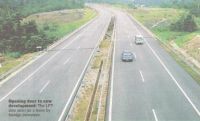Highway to growth in east coast
Category: Publication - The Star
- Highway opens doors for Pahang
Before the East Coast Highway (LPT) was opened to traffic on Aug 1, 2004, the journey from Kuala Lumpur to Kuantan on the federal road could take up to five hours.
However, the 169km LPT from Karak to Kuantan has cut down the traveling time by half, not only to Kuantan but also to other areas in the east coast.
Currently, every day, an average of 16,000 vehicles ply the RM1.2bil highway which is seen as the catalyst for the growth of the east coast corridor. It was opened by Sultan Ahmad Shah of Pahang.
Pahang Housing and Growth Centres Committee chairman Datuk Mohd Soffi Abd Razak said the LPT had opened the door to new development projects and attracted foreign investors to the east coast states.
"Apart from boosting development projects, the LPT is also seen as a boon by foreign investors. As the Klang Valley is getting increasingly congested, Pahang can provide an alternative to local and foreign investors through the LPT," he said.
As the LPT connects major agricultural areas in the state, namely the vast oil palm and rubber plantations, it will ensure the sector continues to grow.
Realising the expressway's potential, the state has outlined projects along the highway's alignment to help boost economic activities.
For example, the areas around Maran, Chini and Lanchang have been earmarked for orchards, agrotourism activities and animal husbandry.
The LPT is also expected to boost new development projects like the Gambang Technology Park that encompasses the Halal Food Hub Park, Biotechnology Centre, E-Village and Agritech Park near the Gambang interchange; the development of a resort city in Jalan Kuantan-Gambang and a new town in Gambang.
Apart from promoting development projects, the LPT is also expected to rev up the local tourism industry and this is already evident from the full occupancy recorded by hotels and chalets during weekends and public holidays.
"The arrival of visitors to tourist destinations has recorded an increase. This is partly because of better roads and the shorter journey, so many Klang Valley residents now opt for Kuantan to unwind during weekends," said Mohd Soffi.
Based on the Pahang State Structural Plan, the Temerloh-Mentakab district has been identified as the second conurbation in the state, with the development focusing on agriculture and industry.
The National Food Terminal has been proposed in Temerloh alongside the Temerloh Integrated Transportation Terminal.
Also, the Bandar Ikan Patin development is an extension to the existing site where small and medium scale industries and aquaculture development are given priority.
Meanwhile, for the Maran district, the development concept proposed is recreational housing.
"A potential area has been identified for development at the Sri Jaya interchange located about 30km from Kuantan, Sri Jaya is expected to benefit from the spillover effects from Kuantan and most likely will see an educational institution and mixed residential projects coming up.
"Nursing colleges, teacher training colleges, as well as public and private institutions of higher learning are most suited to the area," said Mohd Soffi.
Higher educational institutions and aquaculture projects are also proposed near the Karak and Temerloh interchanges while the area around the Maran and Sri Jaya interchanges has been earmarked for housing.
However, the old Kuala Lumpur-Kuantan federal route is still important and several development zones have been identified, mostly aligned along the route. Among the earmarked areas are Karak, Temerloh/Mentakab, Maran, Gambang, Jaya Gading, Kuantan and Gebeng.
These development zones encompass settlements and growth areas along the link roads.
The land development in these areas involves residential/housing projects, commercial/town centres, industrial areas, airport and public, educational and recreational facilities.
Altogether, the projects along the LPT and the old route would have a high economic impact on the areas concerned and would help expand existing agricultural activities.
In a nutshell, the LPT serves as a catalyst for all economic sectors. - Bernama
--- Back to News Listing ---

